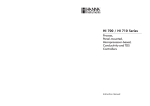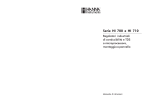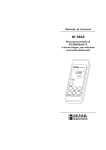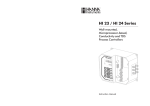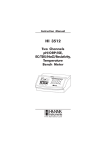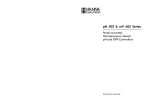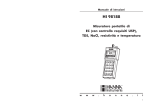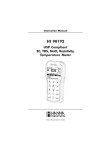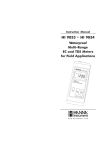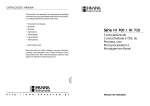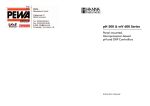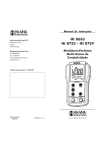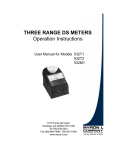Download Manuals/EC 700 and EC 710 Controller
Transcript
EC 700 TDS 705 EC 710 Process, Panel-mounted, Microprocessor-based, Conductivity and TDS Controllers Instruction Manual Dear Customer, Thank you for choosing a Hanna Product. This instruction manual has been written for the following products: EC 700 EC controller with dual setpoint, ON/OFF and PID control, analog output TDS 705 TDS controller with dual setpoint, ON/OFF and PID control, analog output EC 710 EC and TDS controller with dual setpoint, ON/OFF and PID control, analog output TABLE OF CONTENTS PRELIMINARY EXAMINATION . . . . . . . . . . . . . . . . . . 4 GENERAL DESCRIPTION . . . . . . . . . . . . . . . . . . . . . 4 FUNCTIONAL DESCRIPTION . . . . . . . . . . . . . . . . . . 6 MECHANICAL DIMENSIONS . . . . . . . . . . . . . . . . . . 7 SPECIFICATIONS . . . . . . . . . . . . . . . . . . . . . . . . . . . 8 INSTALLATION . . . . . . . . . . . . . . . . . . . . . . . . . . . . 9 Please read this instruction manual carefully before using the instrument. It will provide you with the necessary information for the correct use of the instrument, as well as a precise idea of its versatility. SETUP MODE . . . . . . . . . . . . . . . . . . . . . . . . . . . . 12 These instruments are in compliance with EN 50081-1, EN 50082-1 and EN 61010-1. ANALOG OUTPUT . . . . . . . . . . . . . . . . . . . . . . . . 27 directives CONTROL MODE . . . . . . . . . . . . . . . . . . . . . . . . . 18 IDLE MODE . . . . . . . . . . . . . . . . . . . . . . . . . . . . . 26 CALIBRATION . . . . . . . . . . . . . . . . . . . . . . . . . . . . 28 LAST CALIBRATION DATA . . . . . . . . . . . . . . . . . . . . 36 FAULT CONDITIONS AND SELFTEST PROCEDURES . . 37 EXTERNAL FUNCTIONS . . . . . . . . . . . . . . . . . . . . . 40 STARTUP . . . . . . . . . . . . . . . . . . . . . . . . . . . . . . . 41 EC VALUES AT VARIOUS TEMPERATURES . . . . . . . . . 42 EC/TDS PROBE MAINTENANCE . . . . . . . . . . . . . . . . 43 ACCESSORIES . . . . . . . . . . . . . . . . . . . . . . . . . . . 44 © 1999 Hanna Instruments All rights are reserved. Reproduction in whole or in part is prohibited without the written consent of the copyright owner, Hanna Instruments Inc., 584 Park East Drive, Woonsocket, Rhode Island, 02895 , USA. WARRANTY . . . . . . . . . . . . . . . . . . . . . . . . . . . . . 46 CE DECLARATION OF CONFORMITY . . . . . . . . . . . 47 ISO 9000 Certified Company since 1992 2 3 PRELIMINARY EXAMINATION Remove the instrument from the packing material and examine it carefully to make sure that no damage has occurred during shipping. If there is any noticeable damage, notify your Dealer or the nearest Hanna Customer Service Center immediately. Note Save all packing materials until you are sure that the instrument functions correctly. Any damaged or defective items must be returned in their original packing materials together with the supplied accessories. GENERAL DESCRIPTION EC 700, TDS 705 and EC 710 are real time microprocessorbased EC or TDS controllers. They provide accurate measurements, flexible ON/OFF or proportional control capabilities, analog input and output, dual setpoint and alarm signal. The system is composed of a case inside which the signal conversion circuitry, the microprocessor circuitry and the output power drivers are contained. MAIN FEATURES OF DIFFERENT MODELS • Display: large LCD with 4 ½ 17 mm digits and 3 ½ 10 mm digits. • LEDs: four LEDs are provided for signaling the energizing of relay 1 and 2 (yellow LEDs) and alarm relays (a green and a red LED). • Relays: 1 or 2 output relays for low conductivity or high conductivity dosage (COM, NO and NC contacts) and 1 output relay for alarm condition (COM, NO and NC contacts). • Calibration and Setup procedures allowed only through an unlock password. • Calibration: 2 points with Hanna EC and TDS calibration solutions. • Four different EC working ranges (0 to 199.9µS; 0 to 1999µS; 0 to 19.99mS; 0 to 199.9mS) for EC700 and EC710 models. 4 • Four different TDS working ranges (0 to 100.0ppm; 0 to 1000ppm; 0 to 10.00ppm; 0 to 100.0ppm) for TDS705 model. • Possibility to switch to TDS measurements with conversion factor from 0.00 to 1.00 (EC710 only). • Temperature compensation of the HANNA standard solutions. • Temperature compensation of the EC and TDS reading with temperature coefficient ß selectable from 0 to 10%/°C. • Manual temperature setting when the temperature probe is not inserted or temperature exceeds the upper range. • Last calibration data internally recorded (non-volatile EEPROM memory): calibration date and time, cell constant, calibration solution values. • Input:4-ring EC/TDS probe with cell constant 2.0 ± 10%, or 4-20mA analog input from a transmitter. • Output: - isolated 0-1 mA, 10 KW maximum load (optional); - isolated 0-20 mA, 750 W maximum load (optional); - isolated 4-20 mA, 750 W maximum load (optional); - isolated 0-5 VDC, 1 KW minimum load (optional); - isolated 1-5 VDC, 1 KW minimum load (optional); - isolated 0-10 VDC, 1 KW minimum load (optional). • Real time clock. 5 FUNCTIONAL DESCRIPTION REAR PANEL FRONT PANEL 1. 2. 3. 4. 5. 6. 7. 8. 9. 10. Liquid Crystal Display SETUP key enters setup mode CFM key confirms current choice (and skips to the next item) CAL key initiates and exits calibration mode ! key increases the blinking digit/letter by one when selecting a parameter. Advances forward while in last calibration data viewing mode. Increases the temperature setting when temperature probe is not inserted CAL DATA key last calibration data viewing (enters and exits) " key decreases the blinking digit/letter by one when selecting a parameter. Reverts backward while in last calibration data viewing mode. Decreases the temperature setting when temperature probe is not inserted LCD key exits from setup and reverts back to normal mode (in idle or control phases with the measurement on the display). During EC/TDS calibration, it alternates EC/TDS buffer value and current cell constant on the display. In EC710 model only, it switches between EC and TDS reading # key moves to the next digit/letter (circular solution) when selecting a parameter. Same as ! key during last calibration data viewing mode LEDs 1. 2. 3. 4. 5. 6. 7. 8. 9. 10. 11. Analog Output Power Supply Alarm Terminal Contact 2 - Second Dosing Terminal Timer Hold Contact 1 - First Dosing Terminal Pt 100 Temperature Sensor connector EC/TDS probe connector Power supply output for external transmitter 4-20 mA input from external transmitter Unplug the meter before any electrical connection. MECHANICAL DIMENSIONS FRONT VIEW 6 SIDE VIEW 7 SPECIFICATIONS INSTALLATION Ranges 0.0 to 199.9 µS, 0 to 1999 µS (EC 700, EC 710 only) 0.00 to 19.99 mS, 0.0 to 199.9 mS (EC 700, EC 710 only) 0.0 to 100.0 ppm, 0 to 1000 ppm (TDS 705, EC710* only) 0.00 to 10.00 ppt, 0.0 to 100.0 ppt (TDS 705, EC710* only) -10.0 to 100.0 °C Resolution 0.1 µS, 1 µS (EC 700, EC 710 only) 0.01 mS, 0.1 mS (EC 700, EC 710 only) 0.1 ppm, 1 ppm (TDS 705, EC710 only) 0.01 ppm, 0.1 ppm (TDS 705, EC710 only) 0.1 °C Accuracy ±0.5 % full scale (EC and TDS) ±0.5°C between 0 to 70°C, ±1°C outside (@20°C/68°F) Temperature Compensation Automatic from -10 to 100°C or manual with Temperature Coefficient from 0.00 to 10.00%/°C Typical EMC Deviation ±2 % full scale (EC and TDS) ±0.5 °C Installation Category II Probe HI 7639 4-ring EC/TDS probe (K=2) with built-in 3-wire PT100 temperature sensor and 5 mt shielded cable Analog Input 4 - 20 mA Power Supply 230 ±10% VAC or 115 ±10% VAC, 50/60 Hz Power Consumption 10 VA EC 700, TDS 705 and EC 710 offer a multitude of possibilities, from single and dual setpoints to ON/ OFF or PID dosage, isolated outputs with user-selectable zoom, recorder outputs in mAmps and volts. Use the 3-wire Pt 100 temperature sensor to compensate for the cable resistance and have a precise automatic temperature compensation of the measurements in long distance applications. See the diagram for a recommended installation. Over Current Protection 200 mA 250V FAST FUSE Relays 1 and 2 • Electromechanical relay SPDT contact outputs, 5A-250 VAC, 5A - 30 VDC (resistive load) Alarm Relay • Electromechanical Relay SPDT contact output, 5A - 250 VAC, 5A - 30 VDC (resistive load) Environment 0-50 °C; max 95% R.H. non-condensing Enclosure single case ½ DIN Weight approximately 1.6 kg. (3.5 lb.) * Note: actual TDS range for EC710 depends on TDS factor set. 8 9 • Power Supply: Connect a 3-wire power cable to the terminal strip, while paying attention to the correct live (L), earth (PE) and neutral (N) terminal connections. Power: 115VAC -100 mA / 230VAC - 50 mA. Live Contact: fused inside 200mA. PE leakage current 1 mA; this contact must be connected to ground. • Conductivity input: the default input is from conductivity probe. Connect the EC probe to the terminals #9 on page 7. Connect the cable shield to pin 1, and the other four wires according to the following table: Color Pin # GREEN 2 WHITE 3 RED 4 BLUE 5 • Pt 100 Terminals: these contacts (#8 on page 7) connect the Pt 100 temperature sensor for automatic temperature compensation of measurement. The HI7639 EC/TDS probe has a built-in 3-wire Pt 100 sensor to be connected according to the following table: Color Pin # GRAY 6 BROWN 7 YELLOW 8. If using a different Pt 100, connect it as explained below. In the case of a 2-wire sensor connect the Pt 100 to pins 1 and 3, and short pins 2 and 3 with a jumper wire. If the Pt 100 has more than 2 wires, connect the two wires of one end to pins 2 and 3 (pin 2 is an auxiliary input to compensate for the cable resistance) and one wire from the other end to pin 1. Leave the fourth wire unconnected, if present. 10 Note If the meter does not detect the temperature probe, it will switch automatically to manual temperature compensation with the temperature adjustable through the up and down arrow keys. The “°C” symbol will blink on the LCD. Note All external cables to be connected to the rear panel should be ended with cable lugs. • Analog output: Connect an external recorder with a 2-wire cable to these terminals (#1 on page 7) paying attention to the correct polarity. A wide variety of output signals, either in V or in mA, is available to fit most standards. • Contact 1 and 2: Connect the dosing devices to these terminals (#4 and #7 on page 7) in order to activate and deactivate them according to the selected control parameters. • mA Input: to switch to mA input signal from a conductivity transmitter (e.g. HI8936, HI98143 or HI98144 series) see setup procedure (code 6). Connect the two signal wires from the transmitter to terminals #11 on page 7, paying attention to the correct polarity. An unregulated 10 ÷ 30 VDC - 50 mA max. power supply output (#10 on page 7) is provided to power the transmitter, if needed. Once the installation is completed, select the appropriate working range, the reference temperature (20 or 25°C) and perform conductivity or TDS calibration as described in this instruction manual. Set the control parameters according to the process. 11 SETUP MODE • Then confirm the displayed digit with # and move to the next one. EC 700, TDS 705 and EC 710 offer a multitude of possibilities from ON/OFF or PID dosage to analog recorder output and from alarm to selftest features. The Setup Mode allows the user to set all needed characteristics of the meter. The setup mode is entered by pressing SETUP and entering the password when the device is in idle or control mode. Generally speaking, if the password is not inserted the user can only view the setup parameters (except for password) without modifying them (and the device remains in control mode). An exception is certain setup items, or flags, which can activate special tasks when set and confirmed. Each setup parameter (or setup item) is assigned a two-digit setup code which is entered and displayed on the secondary LCD. The setup codes can be selected after password and CFM are pressed. When CFM is pressed, the current setup item is saved on EEPROM and the following item is displayed. Whenever LCD is pressed, the device reverts back to control mode. The same is true when CFM is pressed on the last setup item. The possible transitions in setup mode are the following: • When the whole password has been inserted, press CFM to confirm it. Note The default password is set at “0000”. • The LCD will display “SET” on the upper part and “c.00” on the lower, allowing the user to edit setup parameters (see table below). • Enter the code of the parameter you want to set, using the arrow keys as per the password procedure above (e.g. 41). • Confirm the code by pressing CFM and the default or the previously memorized value will be displayed with the first digit blinking. Note When the password is not inserted or a wrong password is confirmed, the display will only show the previously memorized value, without blinking (read only mode). In this case, the value cannot be set. Press LCD and start again. ENTERING THE PASSWORD • Press SETUP to enter the setup mode. The LCD will display “0000” on the upper part and “PAS” on the lower. The first digit of the upper part of the LCD will blink. • Enter the desired value using the arrow keys and then press CFM. • Enter the first value of the password by the ! or " keys. 12 13 • After confirmation, the selected parameter is displayed. The user can scroll through the parameters by pressing CFM. In order to directly set another parameter, press SETUP again and enter the code or scroll to it by pressing CFM. The following table lists the setup codes along with the description of the specific setup items, their valid values and whether password is required to view that item (“PW” column): 14 Code Valid Values Default PW 14 Relay 1 deviation (D1) 0.5 to 10% f.s. 1% f.s. no 15 Relay 1 reset time 0.1 to 999.9 minutes 999.9 no 16 Relay 1 rate time 0.0 to 999.9 minutes 0.0 no 21 Relay 2 mode (M2) same as relay 1 0 no 22 Relay 2 setpoint (S2) 0.5 to 99.5% full scale 75% f.s. no 23 Relay 2 hysteresis (H2) 0 to 5% f.s. 1% f.s. no 24 Relay 2 deviation (D2) 0.5 to 10% f.s. 1% f.s. no Code Valid Values Default PW 00 Factory ID 0 to 9999 0000 no 25 Relay 2 reset time 0.1 to 999.9 minutes 999.9 no 01 Process ID 0 to 9999 0000 no 26 Relay 2 rate time 0.0 to 999.9 minutes 0.0 no 02 Control enable/disable 0: C.M. disabled 1: C.M. enabled 0 no 30 Relay 3 high alarm (HA) 0.5 to 99.5% full scale 95% f.s. no HA-Hys>LA+Hys,Hys=1.5%f.s.,HA>S1 or HA>S2 03 Range 1: 0.0-199.9 µS (or 100.0 ppm) 4 (depends on model) 2: 0-1999 µS (or 1000 ppm) 3: 0.00-19.99 mS (or 10.00 ppt) 4: 0.0-199.9 mS (or 100.0 ppt) no 31 Relay 3 low alarm (LA) 0.5 to 99.5% full scale 5% f.s. no LA+Hys<HA-Hys,Hys=1.5%f.s.,LA<S1 or LA<S2 1 to 30 min 5 no 04 Reference Temperature 20°C or 25°C 25°C no 32 Proportional control mode period 05 Temperature Coefficient 0.00 to 10.00 %/°C 2.00 no 33 Maximum relay ON time 1 to 10 min (after which an alarm mode is entered) 10 no 06 Input Selection 0: conductivity probe 1: 4-20 mA input signal 0 no 34 Alarm mask time 00:00 to 30:00 00:00 no 07 Temperature compensation ATC: Automatic User: Manual ATC no 40 Analog output selection 2 no 08 TDS Factor (EC710 only) 0.00 to 1.00 0.50 no 11 Relay 1 mode (M1) 0: disabled 1: ON-OFF high setpoint 2: ON-OFF low setpoint 3: PID, high setpoint 4: PID, low setpoint 0 no 0: 0-1mA 1: 0-20 mA 2: 4-20 mA 3: 0-5 VDC 4: 1-5 VDC 5: 0-10 VDC 12 Relay 1 setpoint (S1) 0.5 to 99.5% full scale 25% f.s. no 13 Relay 1 hysteresis (H1) 0 to 5% f.s. 1% f.s. no 41 Analog output 0 to 100% full scale 0 lower limit (O_VARMIN) (O_VARMIN < O_VARMAX - 5% f.s.) no 42 Analog output 0 to 100% full scale 100% f.s. upper limit (O_VARMAX) (O_VARMIN < O_VARMAX - 5% f.s.) no 15 Note Code Valid Values Default PW 60 Current day 01 to 31 from RTC no 61 Current month 01 to 12 from RTC no 62 Current year 1998 to 9999 from RTC no 63 Current time 00:00 to 23:59 from RTC no 72 Cleaning timer 0 to 9999 days 0 no 73 Initial cleaning day 01 to 31 01 no 74 Initial cleaning month 01 to 12 01 no 75 Initial cleaning year 1998 to 9999 1998 no 76 Initial cleaning time 00:00 to 23:59 00:00 no 77 Cleaning ON interval 0 to 19999 minutes 0 no 90 Display selftest 0: off 1: on 0 yes 91 Keyboard selftest 0: off 1: on 0 yes 92 EEPROM selftest 0: off 1: on 0 yes 93 Relays and LEDs selftest 0: off 1: on 0 yes 94 Watchdog selftest 0: off 1: on 0 yes 99 Unlock password 0000 to 9999 0000 yes 16 Note The process controller automatically checks to ensure that the entered data matches other related variables. If a wrong configuration is entered, “ERROR” blinks on the LCD to prompt the user. The correct configurations are the following: If M1= / 0 then S1<HA, S1>LA; If M2= / 0 then S2<HA, S2>LA; If M1= 1 then S1-H1>LA; If M1= 2 then S1+H1<HA; If M1= 3 then S1+D1<HA; If M1= 4 then S1-D1>LA; If M2= 1 then S2-H2>LA; If M2= 2 then S2+H2<HA; If M2= 3 then S2+D2<HA; If M2= 4 then S2-D2>LA; If M1= 1 and M2 = 2 then S1-H1>S2+H2, S2>LA, HA>S1; If M1 = 2 and M2 = 1 then S2-H2>S1+H1, S1>LA, HA>S2; If M1 = 3 and M2 = 2 then S1>S2+H2, S2>LA, HA>S1+D1; If M1 = 2 and M2 = 3 then S1+H1<S2, S1>LA, HA>S2+D2; If M1 = 4 and M2 = 1 then S1<S2–H2, S1–D1>LA, HA>S2; If M1 = 1 and M2 = 4 then S1–H1>S2, S2–D2>LA, HA>S1; If M1 = 3 and M2 = 4 then S1>S2, S2–D2>LA, HA>S1+D1; If M1 = 4 and M2 = 3 then S2>S1, S1–D1>LA, HA>S2+D2; where the minimum deviation (D1 or D2) is 0.5% of the maximum range value. Note When a wrong setup value is confirmed, the controller does not skip to the next setup item but remains in the current item displaying a flashing “ERROR” indicator until the parameter value is changed by the user (the same is also true for the setup code selection). In some circumstances, the user cannot succeed in setting a parameter to a desired value if the related parameters are not changed beforehand; e.g. to set a EC high setpoint to 10.0 mS the high alarm must be set to a value greater than 10.0 mS first. 17 CONTROL MODE The control mode is the normal operational mode for these meters. During control mode the meter fulfills the following main tasks: • converts information from EC/TDS and temperature inputs to digital values; • controls relays and generates the analog outputs as determined by the setup configuration, displays alarm condition; In EC 710 model it is possible to switch between EC and TDS reading pressing “LCD”. The TDS value is obtained multiplying the EC measurement by the TDS factor set through setup. The EC 700 displays EC only. The TDS 705 displays TDS only, with a TDS factor fixed at 0.5. The status of the meter is shown by the LED’s on the right. STATUS LEDs Alarm LED (green) Relay LED (yellow) Control Alarm Red LED OFF ---- ON OFF ON ON OFF ON ON or OFF OFF ON ON OFF ON or OFF Blinking Meter exits control mode by pressing SETUP or CAL and confirming the password. Note that this command generates a temporary exit. To deactivate the control mode definitively, set CONTROL ENABLE to “0” (item # 02). An upper boundary is imposed for dosage time when relays are energized continuously, i.e. when relay works in ON/ OFF mode or also in PID mode but in the latter case only if the relay is always ON. This parameter can be set through setup procedure. When the maximum boundary is reached, an alarm is generated; device stays in alarm condition until relay is de-energized. ON/OFF CONTROL MODE Either for mode 1 or 2 (high or low conductivity dosage) the user has to define the following values through setup: • relay setpoint (µS/mS/ppm value); • relay hysteresis (µS/mS/ppm value). Connect your device to the COM and NO (Normally Open) or NC (Normally Closed) terminals. The ON relay state occurs when relay is energized (NO and COM connected, NC and COM disconnected). The OFF relay state occurs when relay is de-energized (NO and COM disconnected, NC and COM connected). The following graphs show relay states along with EC measured value (similar graph can be derived for TDS control). As shown below, a high setpoint relay is activated when the measured EC exceeds the setpoint and is deactivated when it is below the setpoint value minus hysteresis. ON OFF RELAY MODES Once enabled, the relays 1 and 2 can be used in four different modes): 1) ON/OFF, high setpoint (low conductivity dosage); 2) ON/OFF, low setpoint (high conductivity dosage); 3) PID, low setpoint (low conductivity dosage); 4) PID, high setpoint (high conductivity dosage). 18 Setpoint – Hysteresis Setpoint EC Such a behavior is suitable to control a high conductivity dosing pump. A low setpoint relay as can be seen from the following graphs is energized when the EC value is below the setpoint and is de-energized when the EC value is above the sum of setpoint and the hysteresis. The low setpoint relay may be used to 19 dition of low or high conductivity solution. An example of how the response overshoot can be improved with a proper rate action setting is depicted in the following graphic. control a low conductivity dosing pump. ON EC OFF Setpoint Setpoint + Hysteresis EC P.I.D. CONTROL MODE PID control is designed to eliminate the cycling associated with ON/OFF control in a rapid and steady way by means of the combination of the proportional, integral and derivative control methods. With the proportional function, the duration of the activated control is proportional to the error value (Duty Cycle Control Mode): as the measurement approaches setpoint, the ON period diminishes. The following graph describes the EC/TDS process controller behavior. Similar graph may apply to the controller. t0 t0+Tc t0+2Tc t0+3Tc During proportional control the process controller calculates the relay activation time at certain moments t0, t0+Tc, t0+2Tc etc. The ON interval (the shaded areas) is then dependent on the error amplitude. With the integral function (reset), the controller will reach a more stable output around the setpoint providing a more accurate control than with the ON/OFF or proportional action only. The derivative function (rate action) compensates for rapid changes in the system reducing undershoot and overshoot of the EC or TDS value. During PID control, the ON interval is dependent not only on the error amplitude but even on the previous measurements. Definitely PID control provides more accurate and stable control than ON/OFF controllers and it is best suitable in system with a fast response, quickly reacting to changes due to ad- 20 RATE ACTION COMPENSATES FOR RAPID CHANGES t PID TRANSFER FUNCTION The transfer function of a PID control is as follows: Kp + Ki/s + s Kd = Kp(1 + 1/(s Ti) +s Td) with Ti = Kp/Ki, Td = Kd/Kp, where the first term represents the proportional action, the second is the integrative action and the third is the derivative action. Proportional action can be set by means of the Proportional Band (PB). Proportional Band is expressed in percentage of the input range and is related to Kp according to the following: Kp = 100/PB. 100% Controller output 0 Error Proportional Band 21 The proportional action is set through the setup procedure as “Deviation” in percent of full scale of the selected range. Each setpoint has a selectable deviation: D1 for setpoint1 and D2 for setpoint2. Two further parameters must be provided for both setpoints: Ti = Kp/Ki, reset time, measured in minutes Td = Kd/Kp, rate time, measured in minutes. Ti1 and Td1 will be the reset time and rate time for setpoint1, while Ti2 and Td2 will be the reset time and the rate time for setpoint2. TUNING A PID CONTROLLER The proportional, integrative, derivative terms must be tuned, i.e. adjusted to a particular process. Since the process variables are not typically known, a “trial and error” tuning procedure must be applied to get the best possible control for the particular process. The target is to achieve a fast response time and a small overshoot. Many tuning procedures are available and can be applied to the EC/TDS controllers. A simple and profitable procedure is reported in this manual and can be used in almost all applications. The user can vary five different parameters, i.e. the setpoint (S1 or S2), the deviation (D1 or D2), the reset time, the rate time and the proportional control mode period Tc (from 1 to 30 minutes). Note SIMPLE TUNING PROCEDURE The following procedure uses a graphical technique of analyzing a process response curve to a step input. 1. Starting from a solution with an EC or TDS value quite different from the dosed liquid, turn on the dosing device at its maximum capacity without the controller in the loop (open loop process). Note the starting time. 2. After some delay (T0) the EC or TDS starts to vary. After more delay, the EC or TDS will reach a maximum rate of change (slope). Note the time that this maximum slope occurs and the EC or TDS value at which it occurs. Note the maximum slope in EC or TDS per minute. Turn the system power off. 3. On the chart draw a tangent to the maximum slope point until intersection with the horizontal line corresponding to the initial EC or TDS value. Read the system time delay Tx on the time axis. 4. The deviation, Ti and Td can be calculated from the following: • Deviation = Tx * max. slope (EC/TDS) • Ti = Tx / 0.4 (minutes) • Td = Tx * 0.4 (minutes). 5. Set the above parameters and restart the system with the controller in the loop. If the response has too much overshoot or is oscillating, then the system can be fine-tuned slightly increasing or decreasing the PID parameters one at a time. User can disable the derivative and/or integrative action (for P or PI controllers) by setting Td = 0 and/or Ti = MAX (Ti) respectively through the setup procedure. Note 22 Connecting an external device (e.g. chart recorder) to the controller, the procedure is easier and doesn’t need the use of hand plotting the process variable (EC or TDS). 23 This is an important feature since with most meters the alarm terminals close only when an abnormal situation arises, however, due to line interruption, no alarm is sounded, causing extensive damage. On the other hand, software is employed to set off the alarm in abnormal circumstances, for example, if the dosing terminals are closed for too long a period. In both cases, the red LED’s will also provide a visual warning signal. The Fail Safe mode is accomplished by connecting the external alarm circuit between the FS•C (Normally Open) and the COM terminals. This way, an alarm will warn the user when EC exceeds the alarm thresholds, during power down and in the case of a broken wire between the process meter and the external alarm circuit. ALARM RELAY The alarm relay functions in the following manner: FS•C = NO (Normally Open) Energized Relay COM FS•O = NC (Normally Closed) De-energized Relay During alarm condition, the relay is de-energized. When not in alarm condition, the relay is energized. Example: High alarm set at 1400 µ S Low alarm set at 600 µS An hysteresis will eliminate the possibility of continuous sequences ‘energizing/de-energizing’ of the alarm relay when the measured value is close to the alarm setpoint. The alarm hysteresis amplitude is 1.5% of full scale. Moreover the alarm signal is generated only after a user selectable time period (alarm mask) has elapsed since the controlled value has overtaken one alarm threshold. This additional feature will avoid fake or temporary alarm conditions. Note If the power supply is interrupted, the relay is de-energized as if in alarm condition to alert the operator. In addition to the user-selectable alarm relays, all EC/TDS controllers are equipped with the Fail Safe alarm feature. The Fail Safe feature protects the process against critical errors arising from power interruptions, surges and human errors. This sophisticated yet easy-to-use system resolves these predicaments on two fronts: hardware and software. To eliminate problems of blackout and line failure, the alarm function operates in a “Normally Closed” state and hence alarm is triggered if the wires are tripped, or when the power is down. 24 Note In order to have the Fail Safe feature activated, an external power supply has to be connected to the alarm device. CONTROL THROUGH ANALOG OUTPUT Models EC 700, TDS 705 and EC 710 have a proportional analog signal (selectable among 0-1mA, 0-20mA, 4-20mA, 0-5VDC, 1-5VDC and 0-10VDC) at the analog output terminals. With this output, the actual output level amplitude is varied, rather than the proportion of ON and OFF times (duty cycle control). A device with analog input (e.g. a pump with a 4-20 mA input) can be connected to these terminals. 25 IDLE MODE ANALOG OUTPUT Idle mode is entered through setup code 2. During idle mode the device performs the same tasks as when it is in control mode except for the relays. The alarm relay is activated (no alarm condition), the control relays are not activated while the analog output remains activated. When the instrument is in idle mode the red and green status LEDs are on. All models are provided with the analog output feature. The output is isolated and can be a voltage or a current. With the recorder, simply connect the common port to the ground output and the second port to the current output or voltage output (depending on which parameter is being used) as depicted aside. The type (voltage or current) and the range of the output analog signal is selectable through the jumpers on the power board. Configurations of the switch are as follows: Output Idle mode is useful to disable control actions when the external devices are not installed or when the user detects unusual circumstances. Control actions are stopped as soon as the user presses SETUP and enters the password. In order to reactivate the control mode, use code 02 of setup (see “Setup” section). Otherwise, the meter remains in idle mode. 26 Switch 1 Switch 2 Switch 3 Switch 4 0-5 VDC, 1-5 VDC OFF ON –– –– 0-10 VDC ON OFF –– –– 0-20 mA, 4-20 mA –– –– ON –– 0-1 mA –– –– OFF –– Choice between different ranges with the same configuration (for example 0-20 mA and 4-20 mA) is achieved via software by entering the setup mode and selecting code 40 (see Setup Mode section for exact procedure). Factory default is switches 1 and 3 closed (ON) and switches 2 and 4 open (OFF), i.e. 0-20 mA, 4-20 mA and 0-10 VDC. In any case, contact the nearest Hanna Customer Service Center for changing of the default configuration. By default the minimum and maximum values of analog output correspond to the minimum and maximum of the selected range of the meter. For example, for the EC 700 with a selected 0 to 1999 µS range and analog output of 4-20 mA, the default values are 0 and 1999 µS corresponding to 4 and 20 mA, respectively. These values can be changed by the user to have the analog 27 output matching a different EC or TDS range, for example, 4 mA = 30 mS and 20 mA = 50 mS. To change the default values, the setup mode must be entered. Setup codes for changing the analog output minimum and maximum are 41 or 42, respectively. For the exact procedure, refer to the setup mode section in the manual. Note The analog output is factory calibrated through software. The user may also perform the calibration procedure as explained in the following. It is recommended to perform the output calibration at least once a year. Note Analog output resolution is 1.5‰ f.s. with 0.5% f.s. accuracy. Note The analog output is “frozen” when entering the setup or calibration mode (after password confirmation). CALIBRATION The user should select the appropriate range to calibrate (setup code 03). Calibration must be performed for each range used. The temperature probe should also be connected to the process meter. The meters are equipped with a stability indicator. The user is also guided with indications on the display during the calibration procedure. Initial Preparation Pour a small quantity of the calibration solution (e.g. 1413 µS) into a beaker. If possible, use a plastic beaker to minimize any EMC interference. For accurate calibration use two beakers containing the same solution, the first one for rinsing the probe, the second one for calibration. By doing this, contamination between the solutions is minimized. To obtain accurate readings, use the calibration solution in the selected range and closer to the values to be measured. Offset Calibration • To perform the EC or TDS calibration enter the calibration mode, by pressing CAL and entering the password. • After the correct password is entered, the control actions stop and the primary LCD will display the first EC or TDS calibration value, with the "CAL" indicator blinking. The secondary LCD displays the temperature. The controller is factory calibrated for temperature as well as for the analog input and outputs. The user should periodically calibrate the instrument for EC or TDS. For greatest accuracy, it is recommended that the instrument is calibrated frequently. Before beginning normal operation,it is recommended to standardize the probe with the Hanna calibration solution close to the expected sample value and inside the selected range. EC AND TDS CALIBRATION The calibration points for EC and TDS are as follows: Range 0.0÷199.9 µS 0÷1999 µS 0.00÷19.99 mS 0.0÷199.9 mS 0.0÷100.0 ppm 0÷1000 ppm 0.00÷10.00 ppt 0.0÷100.0 ppt 28 Calibration point(s) 84.0 µS 1413 µS 5.00 - 12.88 mS 80.0 - 111.8 mS 42.0 ppm 800 ppm 6.44 ppt 55.9 ppt Note If the wrong password is entered the system reverts back to normal operation, displaying EC or TDS values. • 0 is the default value for the 1st calibration point. Dry the conductivity probe and leave it in air. • Only when the reading is stable the "CAL" indicator will stop flashing (after about 30 seconds) and the "READY" and "CFM" indicators will start blinking. • Press CFM to confirm the calibration point; the primary LCD will display the second expected buffer value. 29 If the zero calibration cannot be performed, "ERROR" will blink. Cell constant calibration • Select the solution value on the primary display by pressing ! or " if the selected range has two possibilities (e.g. 5.000 and 12.880 mS). • Immerse the EC/TDS probe with the temperature sensor in the selected solution. The level of solution must be higher than the holes of the EC/TDS probe sleeve. Tap the EC/ TDS probe repeatedly on the bottom of the beaker and stir to ensure that no air bubbles are trapped inside the sleeve. • When the reading is stable, "CAL" will stop flashing (after about 30 seconds) and the "READY" and "CFM" indicators will blink. • Press CFM to confirm the calibration point; if the reading is close to the selected solution, the meter stores the reading. If the reading is not close to the selected solution, "ERROR" will blink. Note 30 A 2-point calibration is always suggested. However the EC/ TDS calibration can also be performed at 1 point. To calibrate offset only, just press CAL after confirmation (with CFM) of the zero reading; the meter will return to normal operational mode. To have the cell constant calibrated first, press the up or down arrow keys after entering the calibration procedure to skip to the next possible calibration buffer. In this case, after confirmation of the cell constant, the meter will ask for the offset calibration displaying zero on the LCD; press CAL to exit or calibrate the offset, if desired. Note The EC or TDS calibration value shown is referenced at 25°C even if the reference temperature of 20°C has been selected. Note During calibration, press LCD to display the cell constant value on the primary display. Press LCD again to return to calibration buffer visualization. Note To interrupt the calibration procedure press SETUP to restart the procedure, or CAL to exit to normal operational mode. Note If the process meter has never been calibrated or an EEPROM reset has occurred, the meter continues to perform measurements. However, the user is informed of an EC or TDS calibration requirement by a blinking “CAL” indication (see “Startup” section). Note The device must be calibrated within the temperature range specified for the EC or TDS buffer solution. CELL CONSTANT DIRECT SELECTION Whenever the EC/TDS probe cell constant is known, it is possible to directly calibrate the meter using that value. • Press CAL to enter calibration mode. The LCD will show the default offset of 0. • Press LCD to display the current cell constant on the primary LCD (factory default value is 2.000 cm-1). • Press SETUP key. • Using !, " and # , enter the probe cell constant (the value must be between 1.333 and 4.000 cm -1) and confirm by pressing CFM. Note If the entered cell constant value is invalid, the “ERROR” indicator blinks on the LCD. Note Press SETUP before CFM to exit without changing the cell constant. CALIBRATION BUFFER DIRECT SELECTION This feature allows to set a user-defined calibration point, in order to perform calibration at a point different from the memorized standards. • Press CAL to enter calibration mode. The LCD will show 0. 31 • Press SETUP key. • Using !, " and # , enter the desired buffer value and confirm by pressing CFM. Calibration procedure may be interrupted by pressing CAL again at any time. If the calibration procedure is stopped this way, or if the controller is switched off before the last step, no calibration data is stored in non-volatile memory (EEPROM). ANALOG INPUT CALIBRATION Note Note Press SETUP before CFM to exit without changes. It is suggested to calibrate the offset before entering the calibration buffer direct selection. TEMPERATURE CALIBRATION The controller is factory calibrated for temperature. However, the user may also perform a one point temperature calibration. This procedure is to calibrate the offset only; the slope will remain as factory calibrated. • Prepare a beaker containing a solution at a given temperature inside the range of the meter. • Use a Checktemp or a calibrated thermometer with a resolution of 0.1° as a reference thermometer. • Immerse the temperature probe in the beaker as close to the Checktemp as possible. • Press and hold first CFM and then CAL to enter the temperature calibration mode. • Execute the password procedure. • Select code 1 via the arrow keys for temperature calibration and confirm with CFM. • CAL will blink on the LCD. The measured temperature will be displayed on both the primary and secondary LCD. • Use the arrow keys to set on the secondary LCD the temperature read by the reference thermometer. • When the reading has stabilized at a value near the calibration point, CAL will stop blinking and an intermittent CFM will prompt the user to confirm the calibration. • If the reading stabilizes at a reading significantly variant from the first setpoint, an intermittent ERROR will prompt the user to check the beaker or bath. 32 The analog input is already factory calibrated. However, the user may also perform a 2-point calibration at 4 and 20 mA. It is sufficient to perform the calibration on one range only. • Connect a mA simulator (e.g. HI931002) to the analog input of the controller (#11 at page 7) • Press and hold first CFM and then CAL to enter the analog input calibration mode. • Execute the password procedure. • Select code 0 via the arrow keys for analog input calibration and confirm with CFM. CAL will blink on the LCD. • The secondary LCD will display “4” for the first calibration point. The primary LCD will display the conductivity reading. • Set the mA simulator to 4 mA and wait for the reading to stabilize, CAL will stop blinking and an intermittent CFM will prompt the user to confirm the calibration. • If the reading stabilizes at a reading significantly variant from the first calibration point, an intermittent ERROR will prompt the user to check the input. • If everything is satisfactory the secondary LCD will display “20” for the second calibration point. • Set the mA simulator to 20 mA and wait for the reading to stabilize, CAL will stop blinking and an intermittent CFM will prompt the user to confirm the calibration. • Press CFM to confirm. The meter will return to normal operational mode. Calibration procedure may be interrupted by pressing CAL again at any time. If the calibration procedure is stopped this 33 • Use the ! or " to make the HI 931002 or multimeter output correspond with the meter’s value shown on the secondary display (e.g. 4). • Wait for approximately 30 seconds (until the reading of the calibrator is stable). • Press CFM to confirm. The meter will switch to the second calibration point. Repeat the above procedure. way, or if the controller is switched off before the last step, no calibration data is stored in non-volatile memory (EEPROM). ANALOG OUTPUT CALIBRATION In the meters where the analog output is available, this feature is factory calibrated through software. The user may also perform these calibration procedures. IMPORTANT It is recommended to perform the output calibration at least once a year. Calibration should only be performed after 10 minutes from power up. • With a multimeter or an HI 931002 connect the common port to the ground output and the second port to the current output or voltage output (depending on which parameter is being calibrated). • Press and hold in sequence CFM first, then # and then CAL to enter the Analog Output Calibration mode. • After the desired readings are obtained, press CFM and the meter will skip back to normal operational mode. Note • Execute the password procedure. • The primary display will show the current selected parameter blinking. Use the ! to select the code (0-5 see chart below) for the desired parameter displayed on the secondary display (e.g. 4-20 mA). • Press CFM to confirm the selected parameter that will stop blinking on the primary display. The secondary display shows the HI 931002 or multimeter input value as lower limit of the interval. 34 When adjusting values using the ! or " keys it is important to allow for sufficient response time (up to 30 seconds) The table below lists the values of output codes along with the calibration point values (which are the analog output minimum and the analog output maximum) as indicated on the display. The secondary display indicates the current calibration point value, while primary display indicates the current calibration type. OUTPUT TYPE CALIBRATION CODE CALIBRATION POINT 1 CALIBRATION POINT 2 0-1 mA 0 0 mA 1 mA 0-20 mA 1 0 mA 20 mA 4-20 mA 2 4 mA 20 mA 0-5 VDC 3 0 VDC 5 VDC 1-5 VDC 4 1 VDC 5 VDC 0-10 VDC 5 0 VDC 10 VDC 35 FAULT CONDITIONS AND SELFTEST PROCEDURES LAST CALIBRATION DATA The meter can display the following last calibration data: • Date • Time • Cell constant While displaying these data, the controller remains in control mode. The data are related to the selected range only. The procedure below indicates the flow. Displaying of the items follows the above sequence. • To begin the cycle press CAL DATA. The last calibration date will appear on the primary LCD as DD.MM format, while the secondary display will show the year. The fault conditions below may be detected by the software: • EEPROM data error; • I2C internal bus failure; • date lost; • code dead loop. EEPROM data error can be detected through EEPROM test procedure at startup or when explicitly requested using setup menu. When an EEPROM error is detected, user is given the option to perform a reset of EEPROM. Note A I2C failure is detected when the I2C transmission is not acknowledged or a bus fault occurs for more than a certain number of attempts (this can be due, for example, to damage sustained by one of the ICs connected to I2C bus). If so, the controller stops any tasks and displays a perpetual sliding message “Serial bus error” (i.e. this is a fatal error). If the meter has never been calibrated or an EEPROM reset has occurred, no calibration data are shown when CAL DATA is pressed. The “no CAL” message will blink for a few seconds, then the meter skips back to normal mode. • Press ! or " to cycle through the data forward or backwards respectively. Note 36 If an invalid date is read from RTC, it is initialized back to the default date and time (01/01/98 - 00:00). The error detection for dead loops is performed by watchdog (see below). You can use special setup codes, perform selftest procedures for LCD, keyboard, EEPROM, relays and LEDs, watchdog. The operation of these functions is outlined in the setup section. The selftest procedures are described in detail in the following subsections. In any moment, by pressing LCD or CAL DATA the meter will return to the regular operating display. • Press ! or # to view the time of last calibration. The secondary display will show "HOU". • Press ! or # again to view the cell constant at the time of last calibration. The secondary display will show "CEL". • Press ! or # again to return to the first CAL DATA display (date) at the time of last calibration. When an EEPROM reset has been performed calibration data are reset to default (every range). An intermittent CAL will blink on the display to advise the user of this status. DISPLAY SELFTEST The display selftest procedure consists of lighting up all of the display segments together. The Display test is announced by a 37 scrolling "Display test" message. EEPROM SELFTEST The EEPROM selftest procedure involves verifying the stored EEPROM checksum. If the checksum is correct the “Stored data good” message will be shown for a few seconds before exiting selftest procedure. The segments are lit for a few seconds and then switched off before exiting the selftest procedure. KEYBOARD SELFTEST If not, the message “Stored data error - Press ! to reset stored data or # to ignore”. The keyboard selftest procedure begins with the message “Button test, press LCD, CAL and SETUP together to escape”. The LCD will then show only a colon. If # is pressed the EEPROM selftest procedure terminates with no other action. Otherwise, EEPROM is reset with default values from ROM as when a device with a virgin EEPROM is switched on. During EEPROM reset a blinking message “Set” is shown on primary LCD; the secondary LCD displays “MEM”. At the end of this operation all the parameters are reset to their default values. The calibrated cell constant is also reset. For this reason the "CAL" flag blinks until the EC/TDS calibration is performed. As soon as one or more keys are pressed, the appropriate segments out of 88:88 corresponding to the pressed keys, will light up on the screen. For example, if CFM and CAL DATA are pressed together the LCD will look like this: RELAYS AND LEDS Relays and LEDs selftests are executed as follows: First all of the relays and LEDs are switched off, then they are switched on one at a time for a few seconds and cyclically. User can interrupt the otherwise endless cycle pressing any key, as indicated by the scrolling message. The colon is a useful indicator for the correct position of squares. Note A maximum of two keys may be pressed simultaneously to be properly recognized. To exit the keyboard test procedure press LCD, CAL and SETUP simultaneously. 38 Note Relays and LEDs test has to be carried out with the relay contacts disconnected from external plant devices. 39 WATCHDOG When a dead loop condition is detected a reset is automatically invoked. The effectiveness of watchdog capability can be tested through one of the special setup items. This test consists of executing a dummy dead loop that causes watchdog reset signal to be generated. EXTERNAL FUNCTIONS HOLD FUNCTION This function allows to perform the maintenance procedures. When the relevant digital insulated input (terminals #6 on page 7) is on, the analog output is frozen at its last value and control and alarm relays are disabled. The “Hld” indication is displayed on the secondary LCD when the function is active. A 5 to 24 VDC voltage can be applied to this input. While in hold state, it is possible to display the temperature reading on the secondary LCD pressing the right arrow key. Only when the key is released, the secondary LCD returns automatically after a few seconds to the “Hld” indication. PRESETTABLE TIMER (CLEANING FUNCTION) A timer is presettable by software to open a digital insulated contact (terminals #5 on page 7) after a user programmable time interval with a minimum interval of 1 day (e.g. for probe cleaning function). The time interval is programmable in number of days through setup code 72. This output is ON for the period set through setup code 77 (this period can be also changed when the output is ON). The starting time of the cleaning timer can be set through setup codes 73, 74, 75 and 76. 40 STARTUP During the automatic startup the Real Time Clock (RTC) is checked to see if a reset occurred since last software initialization. In this case, the RTC is initialized with the default date and time 01/01/1998 - 00:00. An EEPROM reset does not affect the RTC settings. The EEPROM is also checked to see if it is new. If this is the case, the default values are copied from ROM and then the device enters normal mode. Otherwise an EEPROM checksum test is performed (the same is performed during EEPROM selftest procedure). If checksum is correct, normal mode is entered, otherwise the user is asked whether the EEPROM should be reset. If EEPROM reset is requested, default values from ROM are stored into EEPROM as would happen with a new EEPROM. Note that EEPROM data is composed of setup data and calibration data. As for the setup data, the calibration data is assigned default values when an EEPROM reset occurs. An un-calibrated meter can perform measurement, though user is informed that EC or TDS calibration is needed by means of a blinking “CAL”. When the last calibration data is required, the “no CAL” message is displayed if no calibration procedure was performed. Unlike EC/TDS calibration, the user has no information on calibration need for other ranges, other than the awareness that EEPROM was reset. After an EEPROM reset, all calibrations (input and output) have to be performed in order to obtain correct measurements. 41 EC VALUES AT VARIOUS TEMPERATURES EC / TDS PROBE MAINTENANCE Temperature has a significant effect on conductivity. Table below shows EC values at various temperatures for the Hanna calibration solutions. TEMPERATURE °C °F HI7030 HI8030 42 EC VALUES (µS/cm) HI7031 HI7033 HI7034 HI7035 HI8031 HI8033 HI8034 HI8035 HI7039 HI8039 0 32 7150 776 64 48300 65400 2760 5 41 8220 896 65 53500 74100 3180 10 50 9330 1020 67 59600 83200 3615 15 59 10480 1147 68 65400 92500 4063 16 60.8 10720 1173 70 67200 94400 4155 17 62.6 10950 1199 71 68500 96300 4245 18 64.4 11190 1225 73 69800 98200 4337 19 66.2 11430 1251 74 71300 100200 4429 20 68 11670 1278 76 72400 102100 4523 21 69.8 11910 1305 78 74000 104000 4617 22 71.6 12150 1332 79 75200 105900 4711 23 73.4 12390 1359 81 76500 107900 4805 24 75.2 12640 1386 82 78300 109800 4902 25 77 12880 1413 84 80000 111800 5000 26 78.8 13130 1440 86 81300 113800 5096 27 80.6 13370 1467 87 83000 115700 5190 28 82.4 13620 1494 89 84900 117700 5286 29 84.2 13870 1521 90 86300 119700 5383 30 86 14120 1548 92 88200 121800 5479 31 87.8 14370 1575 94 90000 123900 5575 Probe can be compensated for normal contamination by a process of recalibration. When calibration can no longer be achieved, remove the conductivity probe from the system for maintenance. PERIODIC MAINTENANCE Inspect the probe and the cable. The cable used for the connection to the controller must be intact and there must be no points of broken insulation on the cable. Connectors must be perfectly clean and dry. CLEANING PROCEDURE Rinse the probe with tap water. If a more thorough cleaning is desired, remove the sleeve and clean the platinum sensors with a non-abrasive cloth or HI7061 cleaning solution. Reinsert the sleeve in the same direction as before. Recalibrate the instrument before reinserting the probe in the system. Note Always recalibrate the instrument when attaching a new probe. 43 ACCESSORIES CONDUCTIVITY & TDS BUFFER SOLUTIONS HI 7030L 12880 µS/cm (µmho/cm), 460mL HI 7030M 12880 µS/cm (µmho/cm), 230mL HI 7031L 1413 µS/cm (µmho/cm), 460mL HI 7031M 1413 µS/cm (µmho/cm), 230mL HI 7033L 84 µS/cm (µmho/cm), 460 mL HI 7033M 84 µS/cm (µmho/cm), 230 mL HI 7034L 80000 µS/cm (µmho/cm), 460mL HI 7034M 80000 µS/cm (µmho/cm), 230mL HI 7035L 111800 µS/cm (µmho/cm), 460mL HI 7035M 111800 µS/cm (µmho/cm), 230mL HI 7039L 5000 µS/cm (µmho/cm), 460mL HI 7039M 5000 µS/cm (µmho/cm), 230mL HI 7032L 1382 ppm (mg/L), 460 mL HI 7032M 1382 ppm (mg/L), , 230 mL HI 7036L 12.41 ppt (g/L), 460 mL HI 7036M 12.41 ppt (g/L), 230 mL HI 70038P 6.44 ppt (g/L), 25 mL sachets, 25 pcs. HI 70080P 800 ppm (mg/L), 25 mL sachets, 25 pcs. HI 7042 42 ppm (mg/L), 1 L HI 7038 6.44 ppt (g/L), 1 L HI 7037 800 ppm (mg/L), 1 L HI 7055 55.9 ppt (g/L), 1 L ELECTRODE CLEANING SOLUTIONS HI 7061M General Cleaning Sol., 230 mL HI 7061L General Cleaning Sol., 460 mL ELECTRODE CLEANING SOLUTIONS IN FDA APPROVED BOTTLES HI 8061M General Cleaning Sol., 230 mL HI 8061L General Cleaning Sol., 460 mL OTHER ACCESSORIES HI 7639 4-ring EC/TDS probe with built-in 3-wire PT100 temperature sensor and 5 mt shielded cable BL PUMPS Dosing Pumps with Flow Rate from 1.5 to 20 LPH ChecktempC HI 8936A HI 8936B HI 8936C HI 8936D HI 98143 series (4-20mA) HI 98144 series (4-20mA) HI 931002 Stick Thermometer (range -50.0 to 150.0°C) EC Transmitter 0.0-199.9 mS/cm EC Transmitter 0.00-19.99 mS/cm EC Transmitter 0-1999 µS/cm EC Transmitter 0.0-199.9 µS/cm EC Isolated Transmitter 0-10 mS/cm EC Isolated Transmitter 0-4 mS/cm 4-20 mA Simulator CONDUCTIVITY BUFFER SOLUTIONS IN FDA APPROVED BOTTLES HI 8030L 12880 µS/cm (µmho/cm), 460 mL HI 8031L 1413 µS/cm (µmho/cm), 460 mL HI 8033L 84 µS/cm (µmho/cm), 460 mL HI 8034L 80000 µS/cm (µmho/cm), 460 mL HI 8035L 111800 µS/cm (µmho/cm), 460 mL HI 8039L 5000 µS/cm (µmho/cm), 460 mL 44 45 WARRANTY CE DECLARATION OF CONFORMITY All Hanna Instruments meters are guaranteed for two years against defects in workmanship and materials when used for their intended purpose and maintained according to instructions. The probes are guaranteed for a period of six months. This warranty is limited to repair or replacement free of charge. Damage due to accident, misuse, tampering or lack of prescribed maintenance are not covered. If service is required, contact the dealer from whom you purchased the instrument. If under warranty, report the model number, date of purchase, serial number and the nature of the failure. If the repair is not covered by the warranty, you will be notified of the charges incurred. If the instrument is to be returned to Hanna Instruments, first obtain a Returned Goods Authorization number from the Customer Service department and then send it with shipping costs prepaid. When shipping any instrument, make sure it is properly packaged for complete protection. To validate your warranty, fill out and return the enclosed warranty card within 14 days from the date of purchase. Hanna Instruments reserves the right to modify the design, construction and appearance of its products without advance notice. Recommendations for Users Before using these products, make sure that they are entirely suitable for the environment in which they are used. Operation of these instruments in residential areas could cause unacceptable interferences to radio and TV equipment. To maintain the EMC performance of equipment, the recommended cables noted in the user's manual must be used. Any variation introduced by the user to the supplied equipment may degrade the instruments' EMC performance. To avoid electrical shock, do not use these instruments when voltage at the measurement surface exceed 24VAC or 60VDC. To avoid damage or burns, do not perform any measurement in microwave ovens. Unplug the instruments from power supply before the replacement of the fuse. External cables to be connected to the rear panel should be terminated with cable lugs. 46 47 HANNA LITERATURE Water Analysis Handbook Water Treatment General Catalog PRINTED IN PORTUGAL Lab Recording h t t p : / / w w w . h a n n a i n s t . c o m MANEC700R1 04/99 These and many others catalogs, handbooks and leaflets are available from Hanna. To receive your free copy, contact your dealer or the nearest Hanna Customer Service Center.

























